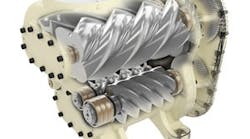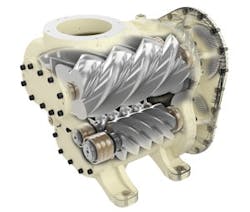When it comes to improving compressor efficiency, the question of staging compression is ever-present. In a perfect world, an infinite number of intercooled stages would yield the highest efficiency. Alas, commercial considerations and the reality of mechanical losses prevent that design from existing.
Compressors often require an increase in the number of stages for reasons other than efficiency. Consider oil-free, dry-running and rotary-screw compressors operating at 100 to 125 psig, which are usually two-stage design systems. Compressing in the first stage at a compression ratio of roughly 3.0 will generate up to 500 degrees Fahrenheit discharge air temperature. Therefore, these compressors use two stages to limit the heat associated with dry-running compression. Allowing for a higher compression ratio and consequently higher heat would require special materials for the rotors, housing, and running gear.
[sidebar id="2"]
Centrifugal compressors use a speed-increasing bull gear in which the number of stages is limited only to the physical dimensions of each of the stages that are mounted around the face of the gear casing. Often, for 100–125 psig designs, centrifugal compressors use three stages of compression for the tradeoff in mechanical losses and efficiency improvement.
For many years, however, oil-injected rotary screw compressors have been able to deliver the typical pressures of 100–125 psig in a single stage of compression. Reasonable efficiency has been attained as the oil acts to remove heat and seal the compression module, keeping discharge temperatures around 200 degrees Fahrenheit maximum.
In an earlier blog post, I wrote about efficiency improving in newer designs as computational fluid dynamics are delivering smarter compression designs. However, I did not address the idea of increased stages delivering additional efficiency. The return on investment is usually not sufficient for small designs under 90 kW.
Above 90 kW, two-stage oil-injected rotary compressors can enjoy lower specific power and still deliver a reasonable ROI. Reducing the compression ratio by dividing into two stages allows for better volumetric efficiency. When one stage of compression is used, the higher compression ratio results in a decay of volumetric efficiency.
What kind of savings can be attained? A 200 kW, 125 psig-rated two-stage compressor can save more than $8,000 per year over a single-stage design when running as a base load compressor around the clock.
Caution: When comparing multiple manufacturers with both single- and two-stage technologies, review each Compressed Air and Gas Institute (CAGI) data sheet (see cagi.org), to ensure that two-stage is the most efficient. Package losses can overcome efficiency improvements in two-stage compressors, or the two-stage design may be older or less efficient than newer single-stage designs, so be sure to compare the performance of different compressors.
Also, when applying variable speed, two-stage can also maintain a higher efficiency versus single-stage across the speed range.
Finally, note that by separating and staging compression, bearing loads are reduced and speeds are slower, extending the longevity of the air end.

